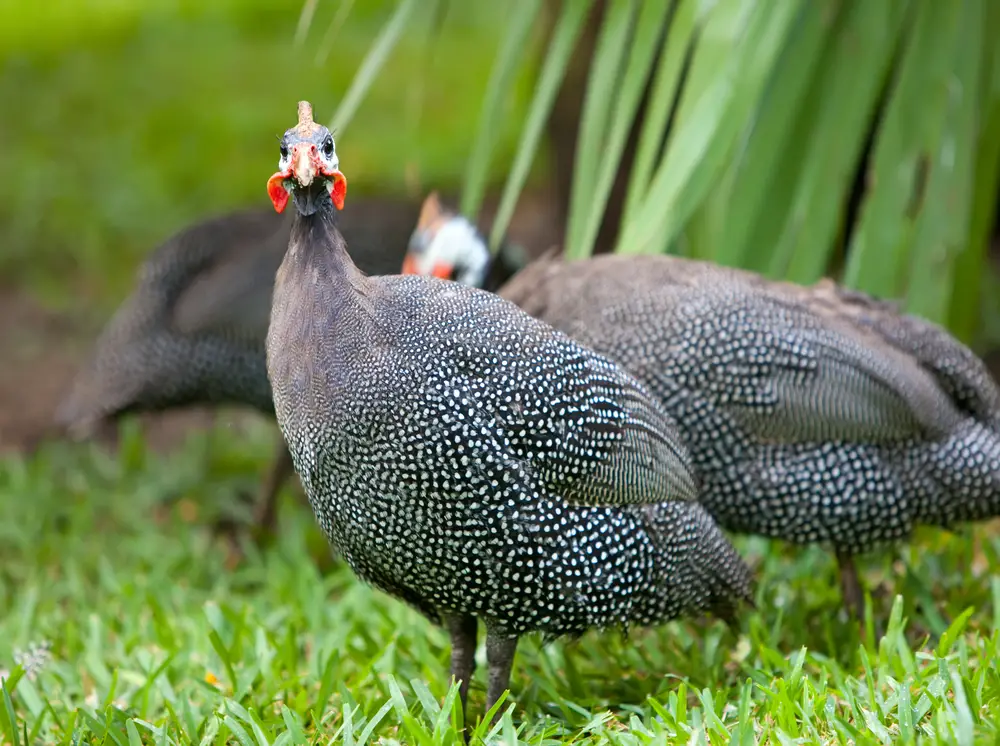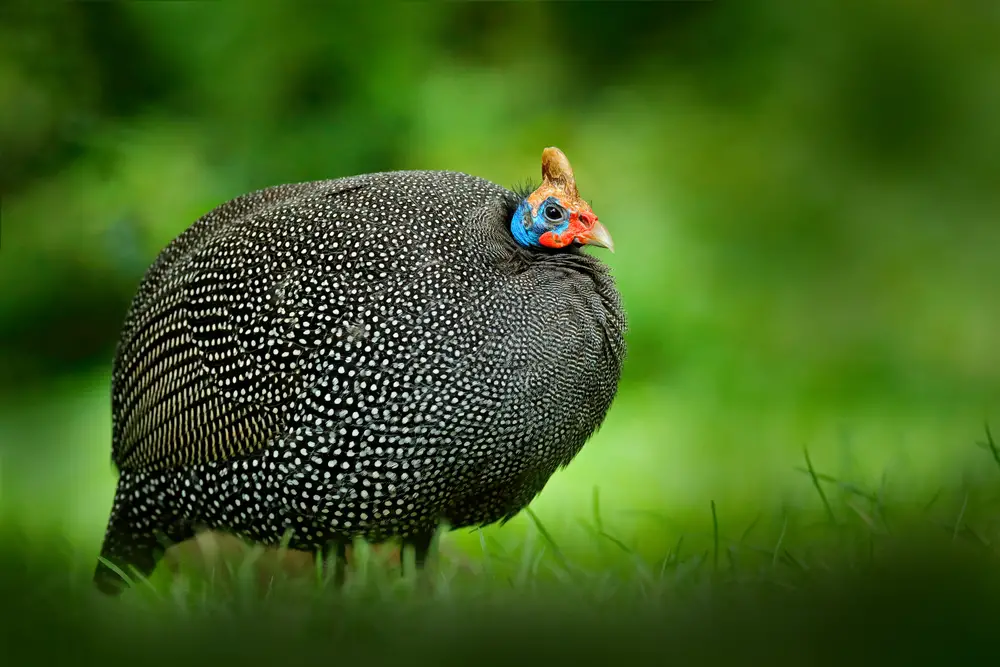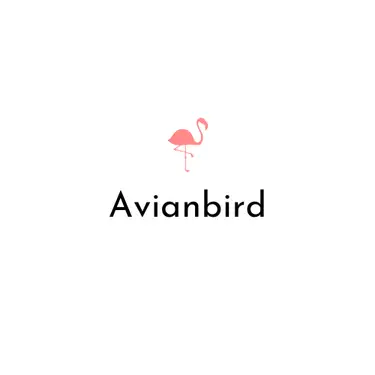Guinea fowl are a unique species of bird native to Africa and the Middle East. They have been kept as domesticated poultry for centuries, primarily due to their ability to control pests such as ticks, snakes, and other insects. In addition to providing a source of food, guinea fowl are becoming increasingly popular among those who enjoy birds in general. This article will discuss the history and characteristics of these remarkable creatures.
The various subspecies of guinea fowl can be divided into two distinct groups: helmeted and crested guineas. Helmeted guineas typically have an unspotted grey plumage with black markings on their head and wings; they also possess keel-like plates on top of their heads resembling helmets which give them their name. Crested guineas feature more colorful plumages including white or yellow spots over dark brown feathers, along with distinctive tufts at the back of the head that resemble crests.
In terms of behavior, both types of guinea fowl demonstrate similar traits such as an affinity for flocking together in large numbers during daytime hours while roosting alone at night. These birds are known to make loud calls when disturbed or alarmed by potential predators; some say that this sound is very reminiscent of laughter—hence why it has been said that keeping a flock around “adds music” to one’s day!

Overview Of Species
Guinea fowl are unique among domesticated birds, in that they are flightless. Though they cannot fly, the guinea fowl species is highly adaptable and can be found living freely all over Africa. In addition to being native to many parts of Africa, guinea fowl have been raised domestically for centuries as a food source.
The most common type of guinea fowl kept today is known as keet which refers to young birds bred for meat or eggs. Keets usually look different from their wild counterparts due to their bright colors and distinct feathers. However, some breeders do raise “true” guineas which more closely resemble their African ancestors with spotted gray-brown feathers.
In terms of behavior, guinea fowl tend to be social animals who will form groups when given the chance. They are also quite noisy creatures making loud calls throughout the day while searching for food or predators on the ground. It is important to note that these birds require plenty of space so if you plan on raising them it is best done outdoors.
Habitat And Range
Guinea fowl are commonly found in a wide variety of habitats, which range from semi-arid regions to tropical forests. Their natural habitat is typically open woodland or savannahs with plenty of cover such as shrubs and grasses for them to hide under when disturbed. They also need access to freshwater and food sources like grains, insects, fruit and small animals.
The geographical range of guinea fowl extends through much of sub-Saharan Africa in the wild. In captivity they have been introduced into parts of Europe, Asia and even North America where they are sometimes kept as farm birds. The range distribution can vary greatly depending on species but generally shows that they prefer drier climates over wetter ones, although a few species do inhabit humid areas too.
Their adaptability has enabled guinea fowl to survive successfully in diverse conditions; however it is still important to provide them with appropriate environment if keeping them as pets since this will ensure their wellbeing is maintained. Guinea fowl require specific needs such as shelter from the elements, an area to dust bathe, space for roosting at night and sufficient feed and water resources throughout the day. Providing these will help keep your birds healthy and contented both physically and mentally.
Physical Characteristics
The physical characteristics of guinea fowl are quite unique and impressive. They come in several size variations, ranging from 13-17 inches in length for the smallest species to 24 inches for the largest. The feather patterns vary greatly between different varieties, but they all share a common trait – small spindly feathers with an overall speckled appearance.
Guinea fowl can also be found in various colors including white, gray, blue, black, slate, lavender and pied. These colorations have been used as a way to differentiate different breeds or species of guinea fowl. Additionally, their beak shape is slightly curved and pointed at the end while their legs tend to be longer than other birds within its family group.
Overall, guinea fowl possess many distinct physical traits that make them stand out among other types of poultry:
- Feather Patterns: Small spindly feathers with an overall speckled appearance
- Size Variations: Ranging from 13-17 inches (smallest) to 24 inches (largest)
- Coloration: White, gray, blue, black, slate, lavender & pied
- Beak Shape: Slightly curved and pointed at the end
- Leg Length: Longer than other birds within its family group
These features combine to create an interesting creature which has been prized by farmers around the world since ancient times. As such it is no surprise that these eye-catching birds continue to remain popular today.
Diet And Eating Habits
Guinea fowl have a very unique diet and eating habits. In order to meet their nutritional needs, they rely on foraging behavior in which they search for food by scratching the ground with their feet or beak. This behavior is mainly done during morning hours when guinea fowl are looking for insects such as beetles, grasshoppers and caterpillars as well as small lizards and frogs.
They also eat various seeds and fruits found in bushes or trees. On occasion, they will consume grains from agricultural fields if available.
In addition to seeking out food items while foraging, guinea fowl can sometimes find supplemental meals near bird feeders or grain spillage sites. With that said, due to their feeding habits being heavily dependent on what’s available within their habitat at any given moment, it’s important that adequate amounts of vegetation remain intact so that guinea fowls may maintain healthy diets throughout all seasons.
The overall health of guinea fowls depends greatly on access to appropriate dietary sources so providing them with additional resources like water dishes filled with fresh drinking water or supplementary foods such as seed mixes is recommended year-round.
Nutritional supplements may also be beneficial during times when natural food sources are scarce or limited. Through these efforts, we can ensure the proper nutrition of wild guineas living in our area and help guarantee the survival of this species into future generations.

Breeding And Reproduction
Guinea fowl breeding is a popular activity for many poultry keepers, as these birds are known to reproduce easily and with success. Guinea fowl reproduction can be achieved in both confinement or free-range settings.
Breeding behavior typically involves the male guinea fowl performing courtship displays such as strutting and bowing, before the female accepts his advances and mating takes place. The incubation period lasts between twenty-six to thirty days depending on environmental conditions; therefore, it is important that suitable nesting locations are provided which are warm and secure from predators.
Egg fertility tends to be high among this species of bird, however there have been reports of infertility associated with poor diet or malnutrition during the winter months. Eggs should not be removed from the nesting site until they are ready to hatch, otherwise fertility may decrease significantly. Proper nutrition throughout the entire year is essential for successful guinea fowl reproduction.
Predators And Threats
Despite their hardiness, guinea fowl are still vulnerable to predation and threats from human activities. Knowing the wide range of predator species that prey on them is important for conservation efforts.
Natural predators include cats, snakes, hawks, owls, foxes and other birds of prey. In addition to these native predators, guinea fowl can also fall victim to domestic animals like dogs and feral pigs.
With increasing urbanization and agricultural development, wild areas suitable for guinea fowls have been reduced significantly in recent years leading to an increase in predation risk due to hunting pressure and habitat loss.
In order to reduce the impact of predators on the population of guinea fowls it is important to provide safe nests or roosting sites where they can sleep during the day without fear of being attacked by other animals or humans.
It’s also essential that farmers protect their land from potential intruders including livestock as well as implement proper fencing which will help keep out predatory animals while providing refuge for guinea fowls at night when they most likely face danger from predators.
Additionally, local wildlife authorities should be informed about any suspicious activity near a known nesting site so appropriate measures can be taken quickly before an attack occurs.
The main factors currently limiting the number of guinea fowl populations around the world are related to its natural predators and hunting pressure caused by humans who hunt them for food or trade purposes.
To ensure healthy populations into the future it’s necessary to create strong management plans which take into account all aspects related with predator control and protection from illegal poaching activities in order to guarantee long-term survival prospects for this remarkable bird species.
Conservation Status
The conservation status of the guinea fowl is a cause for concern due to its dwindling populations in some areas.
The wild population has been declining, and although it remains widespread throughout parts of Africa, threats such as hunting, habitat loss and predation have caused a decrease in numbers. In order to conserve this species, several initiatives have been set up by national organizations and international bodies alike.
These include programs for captive breeding, research into the ecology of guinea fowls, protection of their habitats and public awareness campaigns about the importance of conserving these birds.
Various methods are used to monitor guinea fowl populations, including counting nests or roost sites during surveys and assessing food availability from droppings collections. Such data contribute towards understanding potential causes behind any observed decreases.
Hunting regulations may also be put in place to reduce human-related pressures on the remaining populations. Additionally, conservationists work with local communities to provide incentives that discourage over-hunting while still providing them with economic benefits through ecotourism activities or other means.
In spite of all these efforts, there remain many challenges ahead if we want to ensure a future for guinea fowls where they play an important role within their ecosystems without becoming endangered themselves. To this end, continued monitoring of wild populations is needed alongside further research into how best to protect them going forward.
Conclusion
Guinea fowl are an interesting bird species that inhabit many parts of the world. They have adapted to a variety of habitats and climates, from warm tropical areas to cooler temperate regions.
Their physical characteristics include bright plumage with bold patterns, as well as small wattles on their heads and beaks used for gathering food items. Guinea fowl feed mainly on insects, but also consume other types of invertebrates, plants, seeds and fruits.
Breeding occurs seasonally in most locations and can involve large numbers of birds nesting together in order to protect themselves against predators. Despite being able to survive in many different environments, guinea fowl populations are facing threats such as habitat destruction and overhunting. Conservation efforts need to focus on creating protected areas where these birds can live without fear of human interference or predation.
It is important for us all to understand the importance of conserving this species for future generations. Through careful management of land use we can help ensure that guinea fowl will continue to inhabit our planet for years to come.
By understanding how they interact with their environment we can make sure that any development takes into account the needs of these unique birds so that both humans and animals alike can benefit from healthy habitats capable of supporting diverse wildlife populations.
With an increased awareness about the plight faced by guinea fowl and other threatened species it is possible for us all to take action towards protecting them before it’s too late.

